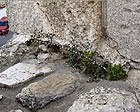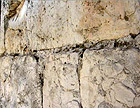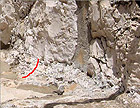|
|
|
Technology
|

|
The survey work also included a technological survey of three subjects that require information for the planning of implementation specifications:
Sealing the top of the wall. There are two reasons that the original sealing on the tops of the crenellations was not preserved: natural weathering and dismantling due to modern intervention during the twentieth century. Remains of the ancient sealing were preserved mostly on the shaded side of the embrasures between the crenellations.
The original sealing was applied in a convex fashion. The remains are indicative of convex sealing, traditional in Ottoman construction. It is reasonable to assume that there was also convex sealing on the top of the crenellations. The slope is inclined in both directions, to the outside of the wall, which face the New City and to the side that faces the direction of the Old City. The slope of the sealing to the outside is steeper (Fig. 27).
Joints. The joints between the stones of the wall are 1-10 cm wide and even greater. This width stems from the coarse stone dressing. Relatively flat pieces of stones (klinim - wedges) were used to fill in the joints. In many places the fa?ade of the stones retreats relative to that of the fa?ade below them. This is due to the structure of the wall which tapers toward the top, such that a small 'step' is formed between the courses (Fig. 28). The original pointing up of the joints was meticulously done and included closing the stone corner which protrudes in order to prevent water from penetrating into it. The modern intervention of pointing up the joints was done at a depth of c. 1-3 cm below the outer surface of the stone. Water can therefore seep into this recess and promote deterioration processes and destruction.
Connection between planes. Remains of the sealing between the horizontal level of the promenade and the vertical plane of the wall point to the existence of a sealing specification - a 'rolka" (a semicircular casting) made of poured lime and stone (Fig. 29).
The Survey Conclusions
|
|

|
| 27. Remains of original slope of the sealing |

|
| 28. 'Step' between the courses |

|
| 29. Remains of original sealing |
|
 |
 |
|
|
| Websites, text and photos © Israel Antiquities Authority |
Powered by teti-tu |
|
|















